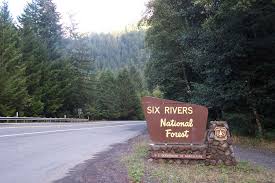Six Rivers, Humboldt County to work together for forest health and hazardous fuels reduction

Press release from Six Rivers National Forest:
The Six Rivers National Forest and Humboldt County have entered into a Good Neighbor Authority (GNA) master agreement to work together to actively restore or improve forest, rangeland and watershed health, including fish and wildlife habitat. An additional focus of the agreement implements the Humboldt County Community Wildfire Protection Plan (CWPP), as well as local CWPPs that tier to it, to reduce hazardous fuels on and near the Six Rivers National Forest.
Steve Madrone, Humboldt County 5th District Supervisor, representing communities such as Orleans and Willow Creek where many of the projects will take place, said, “Humboldt County is very appreciative of this collaborative effort that will create jobs, reduce fuels, enhance habitats, and protect communities. Our rural communities will all benefit from this effort.”
According to Ted McArthur, forest supervisor for the Six Rivers National Forest, “Like many of the agreements and partnerships we’ve entered into over the past several years, the projects that we’re working on are all about restoring the health of our forests and watersheds, as well as keeping our communities safe from devastating wildfires.”
First authorized by Congress as part of the 2014 Farm Bill (www.govtrack.us/congress/bills/113/
hr2642/text) with subsequent updates and expanded authorities, the GNA seeks to improve coordination across federal, state, and private boundaries during hazardous fuels, insect and disease, and watershed restoration projects. Project activities under the GNA can include:
- Forest restoration: Forest stand improvement, prescribed burning, reforestation, insect or disease treatments, biological assessments, heritage surveys, environmental analysis;
- Hazardous fuels reduction: Forest thinning, piling, or burning slash, prescribed burning;
- Fish and wildlife habitat improvement: Fish passages, instream fish structures, developing wildlife water sources; and
- Watershed restoration: Seeding for soil stabilization, decommissioning existing roads.
This is the first master GNA agreement in California with a county. Each year, the forest and county will work together to develop and agree to an operating plan that documents the planned restoration and fuels reduction projects.
For additional information, contact Josh Eichamer, Six Rivers National Forest fire planner, at [email protected] or Cybelle Immitt, Humboldt County natural resources planning manager, at [email protected].

Join the discussion! For rules visit: https://kymkemp.com/commenting-rules
Comments system how-to: https://wpdiscuz.com/community/postid/10599/
Some of the biggest, most devastating fires could have been stopped much easier if there had been access to fight them. Decommission of forest service roads and old logging roads makes no sense. They create access for hunters, campers and other outdoor activities. They also give fire fighters already established fire barriers and access to fight fires. Almost all fires in our area are reported as being in steep, rugged terrain. Why not have roads available instead of having to just watch wildfires burn?
I sort of agree with that Alf.
I’ve seen some roads decommissioned for good reasons, to incorporate a watershed into wilderness designation etc, but others seem to be decommissioned just because they lack maintenance money, or in response to the suburban lobbying of groups like “KS wild” to close roads.
A road is a pretty good fire break out here, or at least provides access to the higher elevations.
There is very little level land, and getting around off trail is fun only for the insane, or kids in their 20’s.😉
Some of the fuel reduction and thinning work that’s been done in my area is starting to look pretty good, 5, 10 years later
If not roads then a robust multi-use trail network. They are ready made hand lines that allow crew access. A lot of trail beds are already established but have been neglected.
Roads are by far the single largest human source of sediment in a watershed. They also fragment wildlife habitat significantly (some species avoid even dirt roads) and provide dispersal avenues for invasive species and diseases that we carry around on our vehicles.
It really is hard to overstate how large the negative impact of roads is on the forest ecosystems and watersheds.
Another issue is neglect of trails for access to the backcountry. The Forest Service has maybe half the trail mileage of 50 years ago. Not just a loss to hikers–firefighters can’t get in either. A particular problem now is lack of maintenance after fires, when brush and deadfall can obscure a route in just a few years.
The only way trail maintenance is done is if there’s a fire in the area…
Cy nature always finds a way